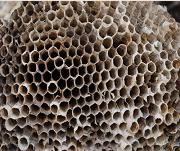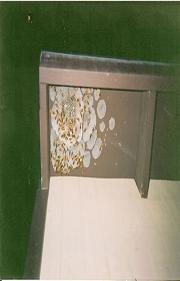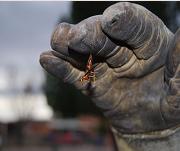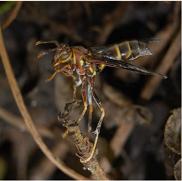



Aggressive Arizona Wasps

Phoenix: 602-670-2222, East Valley: 480-720-7000
West Valley: 623-210-4000, Tucson: 520-743-8000
Pinal County: 520-840-8000
Wasp Removal and Wasp Pest Control Methods
The most common problem wasp species in Arizona are Paper Wasps, often called Arizona Yellow Jackets. Paper Wasps are societal wasps, which mean they live in large groups, and are a pervasive problem wasp species in Arizona. An established wasp colony or, more commonly, a series of wasp colonies can be very dangerous to humans, domestic pets and livestock. Paper Wasps can sting multiple times and will aggressively defend their nesting areas. Although much media attention has been given to Africanized (killer) honeybees, because of their numbers in any given attack, Paper Wasps can be just as aggressive and lethal and will seldom abandon a home nesting site unless dealt with properly. This year, because of our abundant winter rains, we expect to see a significant increase in Paper Wasp colonies throughout central and southern Arizona. West Valley: 623-210-4000, Tucson: 520-743-8000
Pinal County: 520-840-8000
Wasp Removal and Wasp Pest Control Methods
Typically, our competitors will spray a wasp nest, thinking that that will solve the problem. Each Paper Wasp colony, unlike bees, is composed of many fertile females that live in a hierarchy of dominance - the queen being most dominant. If the queen dies, the next most aggressive female will take over and re-establish the colony. Just spraying the nest will simply scatter the fertile female wasps. Each fertile female is capable of laying eggs and, if they are scattered, can create dozens of nests nearby. Each fertile "escapee" will then move out and forage for several days, gorge on nectar and return to a place nearby to start a new colony. Wasps are sensitive to pressure and will flee when any pressurized insecticide is applied near or on a nesting site. Wasps can literally hydrofoil off this pressure and use it to lift them off the nest before the insecticide makes contact. As a result, this is not the best technique to use and often leads to nothing more than scattering the fertile female wasps to make many more nests in the same area. Directly spraying a nesting site will permanently worsen the problem. Wasp colonies have to be approached differently and with some thought given to removing a family of related wasps in more than one location on any residential structure or the surrounding grounds.
As specialists, who have studied Paper Wasp behavior for years, we follow a different, very thorough approach to the problem. We apply a five part process that we have developed, after careful study and many field trials that successfully addresses the problem:
1. We provide a thorough inspection of you residential or commercial structures to identify all possible nesting locations, including roof tops, and include other potential sites on your property including vegetation, debris and possible cavities that they can occupy. Not all nesting sites are exterior, it is very common to find a source nest hidden away in structural cavities or in dense, woody foliage.
2. We map all the sites and then methodically return to each nesting area and apply a simulated pheromone spray that we have developed, over our years of service, that calms the wasp colony and keeps them on the nest site. It also brings in the foraging wasps and retains them at the site.
3. We then apply a quick acting low residual insecticide on the wasp colony that kills the wasps quickly and safely. It also kills any brood in the nest. Any returning foraging females that are still returning will also be affected within a short period of time.
4. We then observe all the different sites for a period of time to insure that there are no returning wasps. This observation period may take up to 45 minutes to an hour depending on the size of the colony.
5. When we are assured that there is no longer any activity at the site, the nest is carefully removed and the connecting materials scrapped off the structure. The site is then treated with a masking agent to remove the possibility of wasps being attracted to the specific nesting site in the future.
Common Wasp Species in Arizona
Paper WaspsA commonly encountered, stinging insect in Arizona is the Golden Paper Wasp, polistes fuscatus. They are common in North American and very plentiful in the Sonora Desert region. They will aggressively defend their nesting sites. Since a single wasp may sting multiple times and still retain its stinger, Paper Wasp infestations are considered potentially very dangerous to humans, livestock and pets.
Paper Wasp, polistes fuscatus, colonies develop through a predictable yearly cycle. It is a matriarchal society dominated by a fertile queen that lays eggs and establishes her position in the colony by aggressive behavior towards other wasps. Other fertile females, called daughters or sisters, are subordinate and determine their position in the hierarchy by aggressive behaviors. If the queen dies, the next most aggressive fertile female in line will take dominance and continue laying eggs. The fertile females, including the queen, take on the burden of initial nest building and foraging. They forage for flower nectar to feed themselves and the adults and for grubs and caterpillars to feed their young.
A typical Paper Wasp nest looks like a grey, conical waffle cone. The wasps make the cells by chewing wood and forming cellulose that hardens into a paper-like material. A nest can be the size of a quarter to the size of a dinner place. The number of wasps in a nest can range anywhere from 15 to well over 100. A family of wasps may also have multiple nests in a general location. The nests may be open and exposed or hidden in crevices and cavities. It is important to realize that in any specific location, you are dealing with a family of related wasps. In a large infestation, there will likely be more than one nesting site.
In the spring, after the initial nest is built by the new queen and her attendant sisters, daughter and worker wasps are incubated. Worker wasps are non-fertile females who protect the nesting site and take over the duties of expanding the nest and feeding the young. They are generally smaller and have noticeably darker wings. Worker wasps are responsible for most wasp attacks. They will respond aggressively and vigorously to any perceived threat in the vicinity of the nesting site. They guard the site and it is common to see them on the exterior of a hidden nesting area.
Male wasps are only produced in the fall at the end of the yearly wasp cycle. They fertilize new daughters who will hibernate in the winter to become queens or sisters in the spring when the weather warms. In most parts of North America, all but the fertilized new daughters die in the winter cold. However, in the Sonora Desert basin, we have found that in our mild winter climate, colonies may survive intact in protected areas. As a result, our desert southwest Paper Wasp colonies can grow to be unusually large in size and, consequently, be more dangerous and defensive of their nesting sites.
Other Local Wasp Species:
There are many common wasp species in the southwest desert. Generally, they can be divided into two groups; social wasps that live in large groups with a structured hierarchy of queens, workers and males, and solitary wasps that live and hunt alone. Some wasps are minor pollinators as they feed on pollen and nectar and others serve the environment as predators of many undesirable insect pests and spiders. All wasps retain their stingers and can sting multiple times. Social wasps can be particularly defensive around their nesting areas and can be dangerous to humans, pets and live stock. Below is a description of commonly encountered species in the desert and some not so commonly encountered that live in our higher elevations and sky islands.
Tarantula Hawk (Pepsis Formosa, Pepsis Thisbe)
Tarantula Hawks are a species of solitary wasps that hunt tarantula spiders for food for their larvae. Mature adult females are about 2" long and have blue black to solid black bodies and bright red or rust colored wings. The stinger of a female can be up to 1/3" long and they pack one of the most painful stings recorded for any insect species. Females persistently hunt for tarantulas and it is not uncommon to see them hover, re-visit and crawl through areas searching for them. They have the habit of constantly flitting their wings when rapidly crawling over the ground as if they are warning passers by of their presence. Males of the species do not hunt, but feed off of flowers of mesquite trees, soap berry trees and milk weeds. Males also have a tendency to stage themselves in high weeds or bushes for periods of time while looking for fertile females. Over the years we have had occasion to see accumulations of males and females gather on mulberry tree leaves in the spring. They fly in and out and briefly position themselves on the leaves as if this were part of a mating ritual or cycle. We have seen as many as thirty males and females do this at any one location and the behavior only lasts for three to five days. Tarantula Hawks are also known to feed on dropped, fermenting fruit and may occasionally be seen working through rotting citrus under trees in a garden. Although gregarious, persistent in searching ground areas and curious, Tarantula Hawks are relatively docile and usually will not sting unless thoroughly provoked.
Mud Daubers (Crabonidae, Trypoxylon politum and Sphecidae, Sceliphron caementarium)
The Organ Pipe Mud Dauber which is jet black and the Black and Yellow Mud Dauber are common throughout the Sonora desert area and are another species of solitary wasps. Mature nest building females can be 1" to 1 ¾" long and have very narrow waists and a long extended abdomen. They give the appearance of looking very sleek and ready for action. Because they commonly build their mud nests around houses; under eaves, inside laundry rooms, in stationary grills and on walls, many people fear them. The Organ Pipe Mud Dauber is known for building long, consecutively joined mud tubes while the Black and Yellow Mud Dauber builds a mud nest that looks about the size and shape of a lemon. They are tremendous predators of orb spiders, jumping spiders and black widow spiders, which they collect, paralyze and deposit with an egg in each nesting cell; sometimes as many as twenty spiders per cell. They can be alarming because of their proximity to areas that people occupy and because of their constant in and out activity during nest building. Mud daubers are relatively docile and seldom sting unless handled. If the mud nests are unsightly, they can easily be removed at night. The wasps are not resident at the nest and will only work on building the nest site during daylight hours.
Velvet Ants (Mutillidae)
Velvet ants are a species of wasps that have wingless females that look somewhat like ants. However they are much larger and generally have bright red, yellow, silver or gold strips of velvet looking hair across their bodies contrasted with black coloration. They are solitary wasps and do not live in communities. Mature velvet ants feed on nectar, and are largely nocturnal although sometimes they may be seen roaming the ground several hours before dusk. There are over 400 species currently recorded in the southwest desert. They are known for their extremely painful sting and the females will raid a bee or wasp ground nest, paralyze the inhabitant and lay their eggs on the carcass to feed the developing young. Velvet ants generally stick to undeveloped desert areas and are not aggressive. However, do not step on one.
Yellow Jackets (Vespula germanica and Vespula vulgaris)
We have had some reports over the years of yellow jacket colonies developed in our higher elevation areas and sky island recreational areas. Generally, these areas have proven to be over 4,000 feet in elevation or higher. To date we have had no reports of them being identified in the lower desert regions.
Yellow jackets are social wasps with distinct castes composed of larger fertile queens, workers, drones and new fertile queens. They can live in very large colonies with up to 4,000 and 5,000 workers and can develop nests with up to 10,000 to 15,000 cells by late summer. Colonies are annual with only newly fertilized queens hibernating and surviving the winter. There have been some reports that in lower elevation areas, yellow jacket colonies may be able to over-winter, but we have no evidence of it at this time. Typically, a yellow jacket is about the same size as a honey bee, about ½" in length, yellow and black and an aggressive forager. There are many stories about yellow jackets ruining a picnic by getting into soda cans, covering hot dogs and hamburgers and harassing people in recreational areas.
Yellow jackets are indiscriminate meat foragers and will harvest just about any meat source available, including dead animal carcasses, insects and your favorite picnic foods to feed their young. They also feed on nectars to support them and are considered minor plant pollinators. Yellow jackets are aggressive, colonize in large numbers and can be very defensive of their nesting area. Like Africanized honeybees, swatting at wasps can aggravate them and cause even more of the wasps to arrive and pursue you.
Bald Faced Hornets (Dolichovespula maculata)
Bald faced hornets are not true hornets, but belong to the Yellow Jacket family. They are social wasps with a distinct caste system; queens, workers, drones and new fertilized queens. They are known for their large football shaped paper nests that can reach up to three feet in length that can house thousands of insects. Nests are usually abandoned in the winter and only the newly fertilized queens survive by hibernation. They are more robust than common yellow jackets and tend to have white faces and black bodies. Bald faced hornet nests are usually found hanging from trees. They are considered minor flower pollinators.
We have had only one unsubstantiated report of bald faced hornet activity on Mount Lemmon over the years, well over 5,000 feet in elevation. If you are hiking and see a large paper nest as described, avoid it. Bald faced hornets are very defensive of their nesting site, can sting multiple times and will pursue a perceived threat for long distances.
AAA Africanized Bee Removal Specialists, Inc. is formed of local professional beekeepers in Phoenix, Arizona and local professional beekeepers in Tucson, Arizona, doing wasp removal in Phoenix, AZ & wasp removal in Tucson, AZ. We are expert wasp control service and wasp extermination service specialists that, since 1970, have been successfully working in professional wasp removal in Adobe, AZ, wasp removal in Ahwatukee, AZ, wasp removal in Ajo, AZ, wasp removal in Amado, AZ, wasp removal in Anthem, AZ, wasp removal in Apache Junction, AZ, wasp removal in Arivaca Junction, AZ, wasp removal in Arivaca, AZ, wasp removal in Arizona City, AZ, wasp removal in Arlington, AZ, wasp removal in Artesia, AZ, wasp removal in Ashurst, AZ, wasp removal in Avondale, AZ, wasp removal in Avra Valley, AZ, wasp removal in Benson, AZ, wasp removal in Bisbee, AZ, wasp removal in Black Canyon City, AZ, wasp removal in Bonita, AZ, wasp removal in Bowie, AZ, wasp removal in Buckeye, AZ, wasp removal in Carefree, AZ, wasp removal in Casa Grande, AZ, wasp removal in Cashion, AZ, wasp removal in Catalina, AZ, wasp removal in Cave Creek, AZ, wasp removal in Central, AZ, wasp removal in Chandler Heights, AZ, wasp removal in Chandler, AZ, wasp removal in Circle City, AZ, wasp removal in Claypool, AZ, wasp removal in Cochise County, AZ, wasp removal in Cochise, AZ, wasp removal in Continental, AZ, wasp removal in Coolidge, AZ, wasp removal in Corona de Tucson, AZ wasp removal in Cortaro, AZ, wasp removal in Desert Hills, AZ, wasp removal in Dos Cabezas, AZ, wasp removal in Double Adobe, AZ, wasp removal in Douglas, AZ, wasp removal in Dragoon, AZ, wasp removal in Dudleyville, AZ, wasp removal in Duquesne, AZ, wasp removal in Eden, AZ, wasp removal in Eleven Mile Corner, AZ, wasp removal in Elfrida, AZ, wasp removal in Elgin, AZ, wasp removal in Eloy, AZ, wasp removal in Estrella Mountain, AZ, wasp removal in Fairbank, AZ, wasp removal in Florence Junction, AZ, wasp removal in Florence, AZ, wasp removal in Fort Grant, AZ, wasp removal in Fort Huachuca, AZ, wasp removal in Fort McDowell, AZ, wasp removal in Fort Thomas, AZ, wasp removal in Fountain Hills, AZ, wasp removal in Friendly Corners, AZ, wasp removal in Gila Bend, AZ, wasp removal in Gilbert, AZ, wasp removal in Gleeson, AZ, wasp removal in Glendale, AZ, wasp removal in Globe, AZ, wasp removal in Gold Canyon, AZ, wasp removal in Goodyear, AZ, wasp removal in Green Valley, AZ, wasp removal in Guadalupe, AZ, wasp removal in Hayden, AZ, wasp removal in Hereford, AZ, wasp removal in Higley, AZ, wasp removal in Huachuca City, AZ, wasp removal in Inspiration, AZ, wasp removal in Johnson Ranch, AZ, wasp removal in Kansas Settlement, AZ, wasp removal in Kearny, AZ, wasp removal in Kelvin, AZ, wasp removal in La Palma, AZ, wasp removal in Laveen, AZ, wasp removal in Litchfield Park, AZ, wasp removal in Lukeville, AZ, wasp removal in Mammoth, AZ, wasp removal in Marana, AZ, wasp removal in Maricopa County, AZ, wasp removal in Maricopa, AZ, wasp removal in Maryville, AZ, wasp removal in McNeal, AZ, wasp removal in Mesa, AZ, wasp removal in Miami, AZ, wasp removal in Miracle Valley, AZ, wasp removal in Morristown, AZ, wasp removal in Mountain View, AZ, wasp removal in Naco, AZ, wasp removal in New River, AZ, wasp removal in Nicksville, AZ, wasp removal in Nogales, AZ, wasp removal in North Scottsdale, AZ, wasp removal in Oracle Junction, AZ, wasp removal in Oracle, AZ, wasp removal in Oro Valley, AZ, wasp removal in Palo Verde, AZ, wasp removal in Palominas, AZ, wasp removal in Paradise Valley, AZ, wasp removal in Patagonia, AZ, wasp removal in Pearce, AZ, wasp removal in Peoria, AZ, wasp removal in Phoenix, AZ, wasp removal in Picacho, AZ, wasp removal in Picture Rocks, AZ, wasp removal in Pima County, AZ, wasp removal in Pima, AZ, wasp removal in Pinal County, AZ, wasp removal in Pirtleville, AZ, wasp removal in Pomerene, AZ, wasp removal in Queen Creek, AZ, wasp removal in Rancho Vistoso, AZ, wasp removal in Randolph, AZ, wasp removal in Red Rock, AZ, wasp removal in Redington, AZ, wasp removal in Rillito, AZ, wasp removal in Rio Rico, AZ, wasp removal in Rio Verde, AZ, wasp removal in Rittenhouse, AZ, wasp removal in Robles Junction, AZ, wasp removal in Rock Springs, AZ, wasp removal in Roosevelt, AZ, wasp removal in Sacaton, AZ, wasp removal in Saddlebrooke, AZ, wasp removal in Safford, AZ, wasp removal in Saguaro, AZ, wasp removal in Sahuarita, AZ, wasp removal in San Jose, AZ, wasp removal in San Manuel, AZ, wasp removal in San Simon, AZ, wasp removal in Santa Cruz County, AZ, wasp removal in Santan, AZ, wasp removal in Sasabe, AZ, wasp removal in Scottsdale, AZ, wasp removal in Sells, AZ, wasp removal in Sierra Vista, AZ, wasp removal in Silverbell, AZ, wasp removal in Solomon, AZ, wasp removal in Sonoita, AZ, wasp removal in South Tucson, AZ, wasp removal in St. David, AZ, wasp removal in Stanfield, AZ, wasp removal in Summerhaven, AZ, wasp removal in Sun City Grand, AZ, wasp removal in Sun City West, AZ, wasp removal in Sun City, AZ, wasp removal in Sun Lakes, AZ, wasp removal in Sunizona, AZ, wasp removal in Sunnyslope, AZ, wasp removal in Sunsites, AZ, wasp removal in Superior, AZ, wasp removal in Surprise, AZ, wasp removal in Swift Trail Junction, AZ, wasp removal in Tempe, AZ, wasp removal in Thatcher, AZ, wasp removal in Three Points, AZ, wasp removal in Tolleson, AZ, wasp removal in Toltec, AZ, wasp removal in Tombstone, AZ, wasp removal in Tonopah, AZ, wasp removal in Tortilla Flat, AZ, wasp removal in Tubac, AZ, wasp removal in Tucson, AZ, wasp removal in Tumacacori, AZ, wasp removal in Vail, AZ, wasp removal in Valley Farms, AZ, wasp removal in Whetstone, AZ, wasp removal in Why, AZ, wasp removal in Wickenburg, AZ, wasp removal in Wilcox, AZ, wasp removal in Winkelman, AZ, wasp removal in Wintersburg, AZ, wasp removal in Wittmann, AZ, wasp removal in Youngtown, AZ.
AAA Africanized Bee Removal Specialists, Inc. is formed of local professional beekeepers in Phoenix, Arizona and local professional beekeepers in Tucson, Arizona, doing wasp removal in Phoenix, AZ and wasp removal in Tucson, AZ. We are expert wasp control service and wasp extermination service specialists that, since 1970, have been successfully performing wasp removals in Arizona., have been successfully working as specialists in wasp control in Adobe, AZ, wasp control in Ahwatukee, AZ, wasp control in Ajo, AZ, wasp control in Amado, AZ, wasp control in Anthem, AZ, wasp control in Apache Junction, AZ, wasp control in Arivaca Junction, AZ, wasp control in Arivaca, AZ, wasp control in Arizona City, AZ, wasp control in Arlington, AZ, wasp control in Artesia, AZ, wasp control in Ashurst, AZ, wasp control in Avondale, AZ, wasp control in Avra Valley, AZ, wasp control in Benson, AZ, wasp control in Bisbee, AZ, wasp control in Black Canyon City, AZ, wasp control in Bonita, AZ, wasp control in Bowie, AZ, wasp control in Buckeye, AZ, wasp control in Carefree, AZ, wasp control in Casa Grande, AZ, wasp control in Cashion, AZ, wasp control in Catalina, AZ, wasp control in Cave Creek, AZ, wasp control in Central, AZ, wasp control in Chandler Heights, AZ, wasp control in Chandler, AZ, wasp control in Circle City, AZ, wasp control in Claypool, AZ, wasp control in Cochise County, AZ, wasp control in Cochise, AZ, wasp control in Continental, AZ, wasp control in Coolidge, AZ, wasp control in Corona de Tucson, AZ wasp control in Cortaro, AZ, wasp control in Desert Hills, AZ, wasp control in Dos Cabezas, AZ, wasp control in Double Adobe, AZ, wasp control in Douglas, AZ, wasp control in Dragoon, AZ, wasp control in Dudleyville, AZ, wasp control in Duquesne, AZ, wasp control in Eden, AZ, wasp control in Eleven Mile Corner, AZ, wasp control in Elfrida, AZ, wasp control in Elgin, AZ, wasp control in Eloy, AZ, wasp control in Estrella Mountain, AZ, wasp control in Fairbank, AZ, wasp control in Florence Junction, AZ, wasp control in Florence, AZ, wasp control in Fort Grant, AZ, wasp control in Fort Huachuca, AZ, wasp control in Fort McDowell, AZ, wasp control in Fort Thomas, AZ, wasp control in Fountain Hills, AZ, wasp control in Friendly Corners, AZ, wasp control in Gila Bend, AZ, wasp control in Gilbert, AZ, wasp control in Gleeson, AZ, wasp control in Glendale, AZ, wasp control in Globe, AZ, wasp control in Gold Canyon, AZ, wasp control in Goodyear, AZ, wasp control in Green Valley, AZ, wasp control in Guadalupe, AZ, wasp control in Hayden, AZ, wasp control in Hereford, AZ, wasp control in Higley, AZ, wasp control in Huachuca City, AZ, wasp control in Inspiration, AZ, wasp control in Johnson Ranch, AZ, wasp control in Kansas Settlement, AZ, wasp control in Kearny, AZ, wasp control in Kelvin, AZ, wasp control in La Palma, AZ, wasp control in Laveen, AZ, wasp control in Litchfield Park, AZ, wasp control in Lukeville, AZ, wasp control in Mammoth, AZ, wasp control in Marana, AZ, wasp control in Maricopa County, AZ, wasp control in Maricopa, AZ, wasp control in Maryville, AZ, wasp control in McNeal, AZ, wasp control in Mesa, AZ, wasp control in Miami, AZ, wasp control in Miracle Valley, AZ, wasp control in Morristown, AZ, wasp control in Mountain View, AZ, wasp control in Naco, AZ, wasp control in New River, AZ, wasp control in Nicksville, AZ, wasp control in Nogales, AZ, wasp control in North Scottsdale, AZ, wasp control in Oracle Junction, AZ, wasp control in Oracle, AZ, wasp control in Oro Valley, AZ, wasp control in Palo Verde, AZ, wasp control in Palominas, AZ, wasp control in Paradise Valley, AZ, wasp control in Patagonia, AZ, wasp control in Pearce, AZ, wasp control in Peoria, AZ, wasp control in Phoenix, AZ, wasp control in Picacho, AZ, wasp control in Picture Rocks, AZ, wasp control in Pima County, AZ, wasp control in Pima, AZ, wasp control in Pinal County, AZ, wasp control in Pirtleville, AZ, wasp control in Pomerene, AZ, wasp control in Queen Creek, AZ, wasp control in Rancho Vistoso, AZ, wasp control in Randolph, AZ, wasp control in Red Rock, AZ, wasp control in Redington, AZ, wasp control in Rillito, AZ, wasp control in Rio Rico, AZ, wasp control in Rio Verde, AZ, wasp control in Rittenhouse, AZ, wasp control in Robles Junction, AZ, wasp control in Rock Springs, AZ, wasp control in Roosevelt, AZ, wasp control in Sacaton, AZ, wasp control in Saddlebrooke, AZ, wasp control in Safford, AZ, wasp control in Saguaro, AZ, wasp control in Sahuarita, AZ, wasp control in San Jose, AZ, wasp control in San Manuel, AZ, wasp control in San Simon, AZ, wasp control in Santa Cruz County, AZ, wasp control in Santan, AZ, wasp control in Sasabe, AZ, wasp control in Scottsdale, AZ, wasp control in Sells, AZ, wasp control in Sierra Vista, AZ, wasp control in Silverbell, AZ, wasp control in Solomon, AZ, wasp control in Sonoita, AZ, wasp control in South Tucson, AZ, wasp control in St. David, AZ, wasp control in Stanfield, AZ, wasp control in Summerhaven, AZ, wasp control in Sun City Grand, AZ, wasp control in Sun City West, AZ, wasp control in Sun City, AZ, wasp control in Sun Lakes, AZ, wasp control in Sunizona, AZ, wasp control in Sunnyslope, AZ, wasp control in Sunsites, AZ, wasp control in Superior, AZ, wasp control in Surprise, AZ, wasp control in Swift Trail Junction, AZ, wasp control in Tempe, AZ, wasp control in Thatcher, AZ, wasp control in Three Points, AZ, wasp control in Tolleson, AZ, wasp control in Toltec, AZ, wasp control in Tombstone, AZ, wasp control in Tonopah, AZ, wasp control in Tortilla Flat, AZ, wasp control in Tubac, AZ, wasp control in Tucson, AZ, wasp control in Tumacacori, AZ, wasp control in Vail, AZ, wasp control in Valley Farms, AZ, wasp control in Whetstone, AZ, wasp control in Why, AZ, wasp control in Wickenburg, AZ, wasp control in Wilcox, AZ, wasp control in Winkelman, AZ, wasp control in Wintersburg, AZ, wasp control in Wittmann, AZ, wasp control in Youngtown, AZ.
www.aaabeeremoval.com

Money Saving Coupons! Click Here


